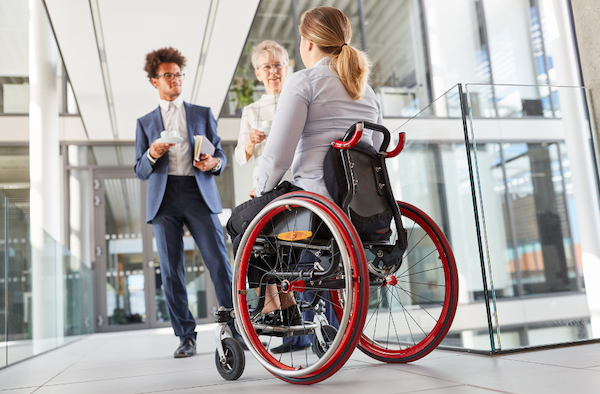The debate between “person first” and “identity first” language centers around how we describe individuals with disabilities or conditions. Both approaches aim to respect and affirm the dignity of the individual, but they differ in their emphasis and implications.
What is the Difference?
“Person first” language prioritizes the individual before their condition. This approach involves stating “person with a disability” rather than “disabled person”. The idea is to highlight the personhood of the individual first and foremost instead of defining them by their disability. This method emerged in the late 20th century as a response to the stigmatization and dehumanization of people with disabilities. By emphasizing the person first, this language aims to recognize the individual’s full humanity and potential beyond their disability.
In contrast, “identity first” language places the condition or disability at the forefront. Terms like “disabled person” or “autistic individual” are examples of this approach. Advocates argue that this method affirms the identity and experiences of the individual, acknowledging that the disability is a significant and inseparable part of who they are. For many, this approach is about reclaiming and owning their identity proudly versus viewing it as something negative or secondary.
Cultural Variations in Usage
The use of “person first” versus “identity first” language varies significantly between cultures. The United Nations (UN) and the European Union (EU) each have developed guidelines and policies regarding the language used to refer to people with disabilities. These guidelines emphasize the importance of dignity, respect, and inclusion in communication.
United Nations
The United Nations Convention on the Rights of Persons with Disabilities (CRPD), adopted in 2006, is a key document outlining the UN’s stance on disability rights and language use. Therein the UN generally supports “person first” language. This approach is seen in many of their documents and communications, emphasizing phrases like “people with disabilities” rather than “disabled persons”. The rationale is to ensure that individuals are seen as persons first, with their disabilities being just one aspect of their identity.
European Union / Europe
The European Union also promotes inclusive language through various policies and frameworks. The European Disability Strategy 2010-2020 and the subsequent Strategy for the Rights of Persons with Disabilities 2021-2030 outline the EU’s commitment to improving the lives of people with disabilities, including through respectful language use.
The EU recognizes the diversity of preferences and approaches across different member states. While “person first” language is widely accepted and used in their documents, the EU also acknowledges the validity of “identity first” language, especially where it is preferred by specific communities or cultures.
But also in Europe, there are communities that recommend “identity first”; for example, the UK based National Autistic Society.
United States
While official guidelines in the U.S. tend to favor “person first” language, there is a notable and growing acceptance of “identity first” language, particularly within certain communities. This shift is driven by advocacy groups and individuals who feel that “identity first” language better reflects their experiences and identity. It is wise to take a closer look at recommendations from different associations:
The following associations recommend ‘person first or - while not recommending it directly - use it in their communication’:
- American Psychological Association (APA)
- Americans with Disabilities Act (ADA)
- Centers for Disease Control and Prevention (CDC)
- Rehabilitation Act of 1973
The following associations recommend ‘identity first’:
- Autistic Self Advocacy Network (ASAN)
- National Association of the Deaf (NAD)
- Disability Rights Movement: Some segments of the broader disability rights movement also advocate for “identity first” language. They argue that this approach can help reclaim and empower their identity, challenging societal views that see disabilities as inherently ‘other’.
Some of these communities are also active in Europe and take the same stance on the European Continent.
Choosing the Best Approach: Respecting Individual Preferences
Determining the ideal approach to use requires sensitivity and respect for individual preferences. While guidelines and general trends exist, the preferences of individuals within any community can vary widely.
- Ask the Person Directly: The most straightforward and respectful method is to ask the individual how they prefer to be identified. This approach honors their autonomy and personal choice.
- Context Matters: Consider the context in which the language is being used. In formal writing or public speaking, it might be appropriate to use "person first” language to align with organizational guidelines. In personal interactions or advocacy settings, “identity first” language may be more appropriate if it aligns with the preferences of the community involved.
- Be Informed and Adaptable: Educate yourself about the preferences and trends within specific communities. For example, many autistic individuals and the broader autism community in both Europe and North America often prefer “identity first” language. Staying informed about these preferences can guide your language choices.
- Respect and Sensitivity: Regardless of the chosen approach, the key is to use language respectfully and sensitively. Avoid making assumptions and be willing to adapt based on the feedback from the individuals or communities you are engaging with.
In conclusion, the choice between “person first” and “identity first” language is nuanced and culturally influenced. It requires a balance of respecting individual preferences, being aware of cultural norms, and using language that honors the dignity and identity of the individuals. The best practice is to engage in open dialogue and listen to the voices of those most affected by these linguistic choices.
At the workplace, companies need to do two things:
- Decide which approach they use in official communications and make it public according to which guideline they decided so
- Communicating clearly to their employees that asking persons directly about their preference is respectful.
Witty helps you to write inclusively in twelve different diversity dimensions around ability and disability.
In these categories, Witty alerts you to expressions that marginalize people based on a definition of - physical, mental, or intellectual - normal. With Witty's suggestions, you contribute to building a space where everyone feels they belong, no matter their size, shape, skin, or hair, illnesses others can't see, or the barriers to their participation they navigate.





